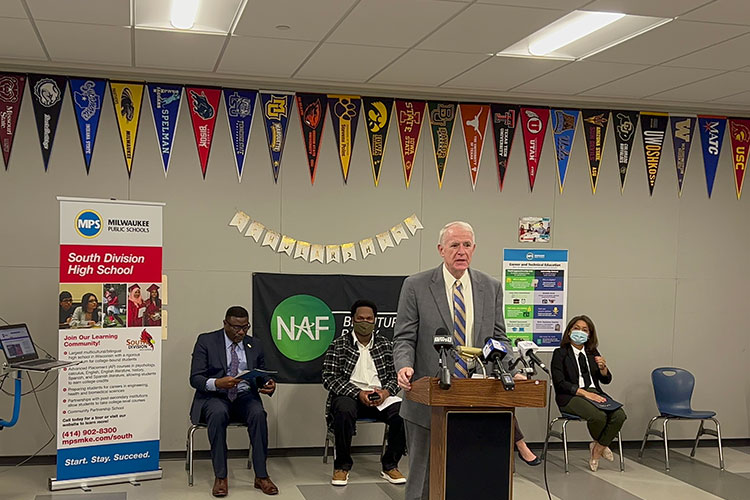Mayor, M³ partners, encourage students to fill out critical FAFSA form

The father of four children, Milwaukee Mayor Tom Barrett draws from personal experience when talking about one of the most important steps that high school seniors can take to attend college.
While the Free Application for Federal Student Aid (FAFSA) can seem daunting at first, the reward is the opportunity to access grants, scholarships, loans and other forms of aid to help pay for a higher education degree.
It’s why Barrett joined leaders from the M3 public education initiative to urge students to turn in their FAFSA forms for the 2022-23 school year amid alarming declines in completion rates during the COVID-19 pandemic. M3 is a partnership among UWM, Milwaukee Area Technical College and Milwaukee Public Schools focused on transforming the future of Milwaukee through education.
Across Wisconsin, 12% fewer high school seniors completed the FAFSA in 2021 compared to 2019, according to the Wisconsin Policy Forum. The aid can be especially important to help students from lower-income households pay for college.
“As a parent, I am well aware that for many individuals, just the word ‘FAFSA’ can alone send you into a tizzy,” Barrett said during a news conference Monday at MPS’ South Division High School. “I think that’s part of the challenge – getting over the fear barrier of simply filling out the form.”
M3 leaders unveiled a series of steps that students and their families can take if they need help filling out the FAFSA. At MPS, students are being directed to mpsmke.com/FAFSA for listings of school and district-wide FAFSA events. Students and parents can also fill out this online form to request assistance.
The 2022-23 application launched Oct. 1. Filing out the form early means no mad dash during the summer before the fall semester begins, and access to advisors and counselors in school who can assist.
“We also know the students and families who most need financial support to attend college may need extra support and encouragement to complete the FAFSA. All of us working together can do just that,” MPS Superintendent Keith Posley said.
“It requires the support of students, parents and guardians, as well as the school and college staff.”
The FAFSA isn’t just for high school seniors.
College students must fill out the form each year they are in school in order to continue to be eligible for aid, since a family’s financial situation may change from year to year. For instance, the MATC Promise program that offers free tuition for eligible students requires a completed FAFSA.
“There is so much attention — and rightly so — on ensuring high school seniors complete the FAFSA,” said Naydeen Gonzalez-De Jesus, MATC executive vice president. “But put simply, if you fill out the FAFSA as a high school senior but don’t do it as a first-year college student, you are putting your aid in jeopardy.”
Here are resources from MATC and UWM:
MATC
- Holds virtual FAFSA Help Sessions every Tuesday — get info at matc.edu/visit.
- Additional MATC Financial Aid information can also be found at edu‘s Costs, Scholarship & Aid page: https://www.matc.edu/costs-scholarships-aid/index.html
UWM
- FAFSA filing tips and an FAQ guide can be found here: https://uwm.edu/onestop/finances/receiving-financial-aid/fafsa/
- UWM students can schedule a virtual FAFSA support appointment here: https://go.oncehub.com/uwmfinaid.
M3 partners see filling out the FAFSA as one of the first steps to help more high school seniors earn college degrees, and part of an overarching goal to have students of color graduate at the same rate as white students to eliminate the equity gap in higher education.
In turn, that can help provide the diverse workforce talent needed to help fill jobs and keep employers in the region, said Phyllis King, UWM vice provost.
“FAFSA needs to be at the center of these conversations as a first step toward future success in college and beyond,” King said.